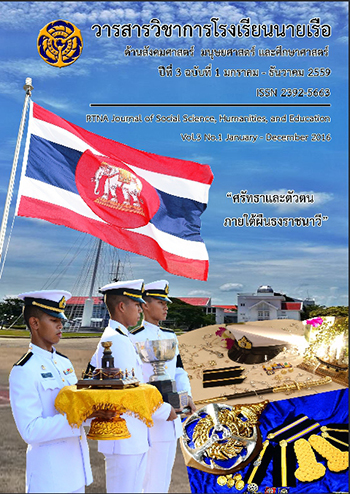แนวทางในการเสริมสร้างคุณธรรมจริยธรรมในสถาบันอุดมศึกษา
คำสำคัญ:
คุณธรรมจริยธรรม, สถาบันอุดมศึกษาบทคัดย่อ
แนวทางในการเสริมสร้างคุณธรรมจริยธรรม เพื่อเสริมสร้างความเป็นบัณฑิตที่พึงประสงค์ ของสถาบันอุดมศึกษา สามารถจำแนกได้ 2 ระดับ คือ ระดับนโยบาย และระดับการปฏิบัติในระดับนโยบายแนวทางในการดำเนินงาน ได้แก่ 1) การกำหนดให้การส่งเสริมคุณธรรมจริยธรรม เป็นนโยบายหลักของสถาบัน 2) กำหนดกฎระเบียบข้อบังคับและบทลงโทษต่างๆที่เกี่ยวข้องให้ชัดเจนและบังคับใช้อย่างจริงจัง 3) กำหนดแนวทางการปฏิบัติในการสอดแทรกคุณธรรมจริยธรรม แก่นิสิตนักศึกษาทั้งภายในและภายนอกหลักสูตรการศึกษาให้ชัดเจนทั้งวิชาการ การกำกับติดตามและประเมินผล ในส่วนระดับการปฏิบัติ ได้แก่ 1) การกำหนดแผนงานโครงการ และกิจกรรมให้ชัดเจนทั้งในวิธีการ ตัวชี้วัด ช่วงเวลา งบประมาณ ผู้รับผิดชอบและการประเมินผล 2) ดำเนินกิจกรรมตามแผนด้วยวิธีการ ที่หลากหลายอย่างต่อเนื่องกับนักศึกษาทุกชั้นปี 3) ผู้บริหาร คณาจารย์ และบุคลากร ควรปฏิบัติตัวให้เป็นตัวอย่างที่ดีในการมีคุณธรรมจริยธรรม 4) กำหนดพฤติกรรมบ่งชี้คุณธรรมจริยธรรมให้ชัดเจน 5) ให้นิสิตนักศึกษาเป็นกลไกสำคัญในการทำกิจกรรมปลูกฝังคุณธรรมจริยธรรม 6) กำหนดให้นิสิตนักศึกษามีสมุดบันทึกคุณธรรมจริยธรรม และ 7) ควรมีการเชิดชูและยกย่องคนดีมีคุณธรรมจริยธรรม หรือบุคคลตัวอย่าง เพื่อเป็นการสร้างค่านิยมคนดีให้เกิดขึ้นในสถาบัน
เอกสารอ้างอิง
กระทรวงศึกษาธิการ (2552) ประกาศกระทรวง ศึกษาธิการเรื่องกรอบมาตรฐานคุณวุฒิ ระดับอุดมศึกษาแห่งชาติ พ.ศ.2552
ฉลอง ใจสะอาด และคณะ (2552) รูปแบบการเสริมสร้างคุณธรรม จริยธรรมของนิสิตนักศึกษา สถาบันอุดมศึกษาไทย. สาขาวิชาบริหารการศึกษา มหาวิทยาลัยนเรศวร.
นฤมล โอสถานุเคราะห์ (2549). แนวทางการพัฒนาคุณธรรม จริยธรรมของนิสิตนักศึกษาในสถาบันอุดมศึกษา ตามพระบรมราโชวาทของพระบาทสมเด็จพระเจ้าอยู่หัว. แหล่งที่มา https://www.bu.ac.th/knowledgecenter/epaper/july_dec2007/Narumol.pdf (12 เมษายน 2558)
อัจฉรา ไชยูปถัมภ์, ประอร สุนทรวิภาต และคณะ. (2558). การพัฒนาตัวบ่งชี้คุณธรรมจิยธรรมและแนวทางปฏิบัติเพื่อเสริมสร้างความเป็นบัณฑิตที่พึงประสงค์ของสถาบันอุดมศึกษาในเครือข่ายสถาบันอุดมศึกษาเขตภาคกลาง. เอกสารรายงานผลการวิจัย สำนักงานคณะกรรมการการอุดมศึกษา
ดาวน์โหลด
เผยแพร่แล้ว
ฉบับ
ประเภทบทความ
สัญญาอนุญาต
เนื้อหาและข้อมูลในบทความที่ลงตีพิมพ์ในวารสารวิชาการโรงเรียนนายเรือ ด้านสังคมศาสตร์ มนุษยศาสตร์ และ ศึกษาศาสตร์ ถือเป็นข้อคิดเห็นและความรับผิดชอบของผู้เขียนบทความโดยตรง ซึ่งกองบรรณาธิการวารสาร ไม่จำเป็นต้องเห็นด้วย หรือร่วมรับผิดชอบใด ๆ
บทความ ข้อมูล เนื้อหา รูปภาพ ฯลฯ ที่ได้รับการตีพิมพ์ในวารสารวิชาการโรงเรียนนายเรือ ด้านสังคมศาสตร์ มนุษยศาสตร์ และ ศึกษาศาสตร์ ถือเป็นลิขสิทธิ์ของโรงเรียนนายเรือ หากบุคคลหรือหน่วยงานใดต้องการนำทั้งหมดหรือส่วนหนึ่งส่วนใดไปเผยแพร่ต่อหรือเพื่อกระทำการใด ๆ จะต้องได้รับอนุญาตเป็นลายลักษณ์อักษร จากโรงเรียนนายเรือก่อนเท่านั้น






